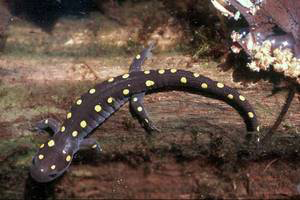The egg masses of spotted salamanders sometimes contain green algae that use the carbon dioxide produced by the embryos and in turn produce oxygen that the salamander embryos can use. This is an example of a symbiotic relationship.
Photo Credit: Geoffrey A. Hammerson
Ambystoma maculatum
Common Name: spotted salamander
Animal Guild: Amphibian
Class > Order > Family: Amphibia > Caudata > Ambystomatidae
What does the species look like?
Spotted salamanders have smooth skin with vertical grooves on each side of the torso, a broad head, and small eyes. The upper side is black with numerous rounded yellow or orange spots. The belly is slate gray. Maximum total length is about 9.8 inches (25 cm). Large larvae have large external gills, a reticulated pattern on the upper surface, small dark spots on the lower sides, and a pale belly; they lack dark stippling on the throat. Egg masses are up to several inches in diameter, have clear to milky or green jelly, and contain usually several dozen eggs.
Where is the species found?
States & Provinces
AL, AR, CT, DC, DE, GA, IL, IN, KY, LA, MA, MD, ME, MI, MN, MO, MS, NB, NC, NH, NJ, NS, NY, OH, OK, ON, PA, PE, QC, RI, SC, TN, TX, VA, VT, WI, WV
Distribution
Range extends throughout most of the eastern United States (except Florida) and adjacent southern Canada; west to eastern Iowa and eastern Texas.
Spotted salamanders inhabit hardwood and mixed forests, in the vicinity of swamps and vernal pools. They are usually underground or under soil surface objects except during the breeding period. Logs, stumps, and mammal burrows provide important cover.
General Phenology and Life History
Rain and warming temperatures stimulate migrations to breeding ponds in winter or early spring. Migrations to breeding sites occur in March-April in the northern part of the range, mainly December-February in the south. In eastern Missouri, migration to ponds occurred after first week of February on all days when mean 3-day temperature at least 5.5 C and precipitation at least 4 mm. Migrations between nonbreeding and breeding habitats extend up to several hundred meters. Breeding sites include vernal pools and semipermanent or permanent ponds in or adjacent to forest. In most areas, spotted salamanders breed nearly exclusively in ponds that are inaccessible to predatory fishes. After arriving in the breeding pools, females pick up sperm from the spermatophores that males deposit on the pool bottom. Soon thereafter females attach masses of eggs to submerged stems or other submerged objects. Individual females deposit up to 250 eggs (average <100); eggs of an individual females may be laid in one large mass or divided among several masses of about 50-90 eggs. Hundreds of females may deposit eggs in a single pool, and the egg masses of different females often exhibit an aggregated dispersion pattern. Larvae hatch in 1-2 months, metamorphose in 2-4 months or rarely overwinter in the pond. Newly metamorphosed individuals live on land for a few years before returning to water to breed (usually in their natal pool).
Which phenophases should I observe?
Do you see/hear...?
Activity
Adults on land More...
For abundance, enter the number of individual animals observed in this phenophase.
Adults in water More...
For abundance, enter the number of individual animals observed in this phenophase.
Adults feeding For abundance, enter the number of individual animals observed in this phenophase.
Reproduction
Fresh eggs For abundance, enter the number of individual animals observed in this phenophase.
Development
Dead adults For abundance, enter the number of individual animals observed in this phenophase.
What do these phenophases look like?
There is currently no photoguide available for this species. If you'd like help us create one, use the guidance document and species template provided here . Then send it via email to education@usanpn.org when it is complete.
